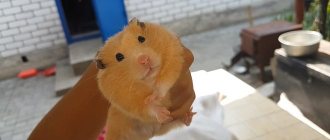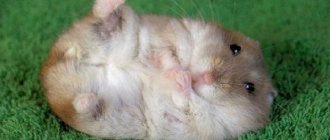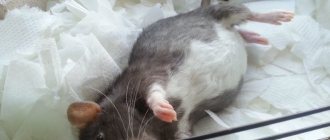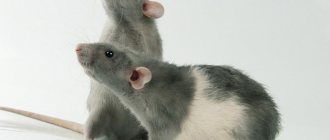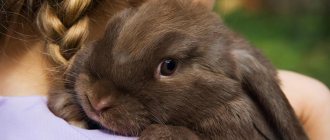Let's start with a couple of lines of encyclopedic information. Do you want to know where your animal comes from and what it is like? And then we’ll immediately talk about caring for Syrian hamsters.
One of the cutest pets.
Syrian hamsters (aka royal, golden, golden) were first mentioned in the 18th century, but a scientific description appeared only in 1836. They were discovered near Aleppo (Syria), which is why they got their name. After this, the rodent was considered extinct for a long time, because The stubborn Syrian hamster did not show itself to the researchers.
The cunning Syrian, foreseeing the future of toys for children and laboratory “consumables” (joke), migrated to the territories of modern Israel, Turkey, Iran, the Balkans, where he still lives safely.
The Syrian hamster hid for almost 100 years, and in 1930, an Israeli zoologist discovered a female with 12 hamsters. Only 4 survived, but this was enough for the rodent to become one of the most popular pets in our time.
What does a Syrian look like and how big will it grow?
Description. The Syrian hamster is a rodent belonging to the hamster family. It has a dense, “strongly built” body - the largest among domestic hamsters. The tail is small and inconspicuous. The predominant color is golden (we’ll talk about types of coats and colors below).
There are rumors that the Syrian hamster has 5 toes on its hind legs and 4 on its front legs. This is not true, there are also 5 on its front legs. It’s just that the thumb is so poorly developed that you can’t even see it.
The average length of an adult royal hamster is 12 cm, the weight of a male is 100-130 g, females - 110-140. But under conditions of good care and nutrition, some eat up to 12 cm in size and weigh 200 g. This is not the result of obesity, just a large animal - it looks almost like a guinea pig.
When choosing a sex, keep in mind that a mature male is more friendly and easier to tame. Female Syrian hamsters often have a bad and aggressive mood.
An adult male with a female in comparison (the female is bicolor).
Solid color (self) in guinea pigs
Short-haired guinea pigs with a single color are distinguished into a separate breed called the English Self, as they were bred by British breeders. Other breeds may also have a solid color. A distinctive feature of animals is that their fur coat is painted in a certain solid color, without admixture of other shades. The paw pads, ears and nose should be the same color as the coat, although they may be a little lighter than the rest of the body.
The color palette of the selfie color is presented in a variety of options, from light tones (white, beige, golden) to rich dark shades such as blue, black and chocolate.
White
The white guinea pig has a snow-white coat without a single spot. The paws and ears of animals are white or pale pink. The eyes are black or brown with a red tint.
White color
The fur of pigs is milky in color with a slight tint of pale yellow.
Cream color
Beige
Beige guinea pigs have light cream fur with a yellowish or sandy tint. Animals have brown or red eyes.
Beige colorSaffron and buff
The fur of pigs with this coloring is distinguished by a deep light yellow tone, similar to the color of roasted peanuts. If an animal has black eyes, then it is classified as the buff color variant. Animals with dark red eyes are called saffron.
Saffron color
Buffalo
This is a new and still rare hair color in guinea pigs, characterized by a rich dark yellow hue. It differs from the golden or saffron color in its even tone, without an apricot or lemon tint. The paws and ears have such a deep yellow tint, the eyes are brown or red.
buffalo color
Gold
The fur of rodents is colored light red or has a reddish-carrot tint. The pig's fur is shiny with a golden tint.
Gold color
Red
In animals, the fur coat is colored a thick reddish-red color with a copper tint. The ears and eyes of the animals have a dark brown tint. Interestingly, males with a red self have a richer and brighter color, while females have a muted reddish fur color.
Color red
Black
The fur of the animals is uniformly colored in a rich coal-black color. The ears, paw pads and eyes also have a deep black tint.
Black color
Blue
In fact, the animals have not blue, but dark blue fur, which only has a bluish tint in bright light. The ears, eyes and paws match the tone of the main color.
Blue color
Chocolate
The coat of animals has a rich dark brown color, chocolate or coffee shade. The eyes of rodents are black or ruby red.
Chocolate color
Slate
It differs from the chocolate color by a lighter brown tone, comparable to the color of milk chocolate.
Slate color
Lilac (lilac)
The animals have dark smoky-gray fur with a slight lilac tint. The ears and paw pads are also gray, and the eyes are black or dark brown.
Lilac color
Satin (satin)
Satin is not a color, but a type of coat. Satin guinea pigs have soft, smooth and extremely shiny coats. The fur of rodents resembles satin or silk, as it shimmers with a glossy sheen. The color of the fur coat can be any, but golden, buffalo and lilac colors are considered the rarest and most valuable.
Satin guinea pigs
Types of fur of the royal rodent
There are 3 main varieties of Syrian hamsters based on their coat type.
Satin . Classic shorthaired Syrians. Often the coat is "glossy", which makes the hamster shine in the light.
Long-haired . A detachment of royal rodents with long hair (individuals with a hairstyle 8-10 cm long are known). Often these Syrian hamsters are also called Angora or Persian. The abundant coat requires special care, so we have dedicated separate material on the website to Angora pets.
And I'm not the shaggiest yet!
Rex. Bred relatively recently, they are covered with thick wavy hair that looks like curls.
Campbell
Like the previous species, it belongs to the family of dwarf rodents. An inexperienced rodent lover can easily confuse them with the Djungarians, but the Campbell's are distinctive in character and appearance.
Campbell cats are characterized by small ears and no fur on their soles. Regarding behavior, hamsters of this species are difficult to train. In addition, they love to bite. When keeping several individuals, it is highly not recommended to leave them in a cage together: this can cause damage or even death.
Keeping rodents of this species requires a spacious terrarium: they are extremely active, so they will need a lot of space to run.
lovelyhamster.ru
Colors of Syrian hamsters
The original color of the Syrians is golden (reddish-red, sometimes called peach). But now Syrian hamsters have been bred to come in almost any color. List of main colors of Syrian rodents:
- White (sometimes snow white is distinguished separately)
- Beige
- Yellow
- Smoked
- Copper
- Sable
- Black chocolate
- Grey
Classic color.
Dzungarian
Quite cute little animals that grow 10 centimeters in length, and their weight can be a maximum of 50 grams. Most often they have a light brown color and a characteristic dark stripe on the back. However, sometimes you can find representatives of this black breed, not only at home, but also in the wild. Breeders have learned to obtain different colors of dzungaria.
These babies are completely tame, in extremely rare cases they are capable of showing aggression and require love and care. Hamsters are afraid of sudden movements and loud sounds and are easily frightened. Hibernation is not relevant for this breed.
Caring for a Syrian Hamster
Proper maintenance and care of a royal hamster consists of:
- Have a comfortable home
- Physical activity
- Hygiene
- Good nutrition
- Protection from stress
- Veterinary treatment
What should a pet's house (cage) be like?
Recommendations for house size for the Syrian breed vary greatly, we will try to answer this question as simply as possible. Choose a cage of such a size that maintenance is easy and it can accommodate:
- House for the night
- Toilet
- Utensils for food
- Drinking bowl
- running wheel
Place accessories freely so that the toilet and eating area are as far apart as possible. Additional options in the form of a labyrinth or a second or third level will make the adult pet’s home more comfortable.
What to prefer: a cage, an aquarium, a terrarium or something else? The most suitable option is a cage, and it is easier to care for than other options. An aquarium of sufficient size is also good, but the cage has better air circulation. Good options include a terrarium or a homemade glass shelving unit.
Do not keep your Syrian hamster in a jar or cardboard box. They are too crowded and the small rodent has to sleep in its own excrement. And the lack of “sports equipment” will greatly affect the baby’s health (we will cover this issue a little lower).
Place the house in a quiet place - caring for a Syrian rodent involves the absence of noise. Sudden loud noises will cause him stress and possibly inappropriate behavior. Those. the living room and kitchen are not suitable. The bedroom is also not an option: the hamster is a nocturnal animal and will not let you sleep. One way out is to leave the cage in the bedroom during the day and move it to the living room at night.
Why does a Syrian hamster need to exercise?
In the wild, a hamster runs up to 12 km per night - there is no feeder, and food must be looked for. At home, with proper care, there is plenty of food, it’s not far to run for it. As a consequence - obesity and all the ensuing consequences (problems with the cardiovascular, endocrine systems, musculoskeletal system). Simply put, it will become more difficult for the pet to move, a heart attack is possible, and the likelihood of diabetes increases (although it is much less than in dwarf varieties).
This is why wheels and labyrinths are placed in the cage. You can also use a special walking ball for hamsters.
We strongly do not recommend walking on the street. Open spaces, noise, sunlight will lead to severe stress after the comfort of an apartment. There is also the possibility of picking up parasites somewhere on the lawn or simply losing a nimble little one.
Luxurious apartment with a gym for a rodent.
Hygiene for a healthy hamster
The royal hamster will definitely equip a toilet in the house. You should not try to accustom him to a certain place - it will be easier to care for if you see where he chooses a latrine, and only then install a kennel and a bowl of food as far away as possible.
There should be filler on the floor of the cage, the layer thickness is 2 cm. Typically used:
- Sawdust
- Corn filler
- Granulated
- paper
Experiment for yourself, which is more convenient and fits your budget. Pieces of paper are a cheap care option, but choose ones without fragrances or other additives. Your pet may develop allergies, and in the worst case, poisoning when he tries to eat the bedding. The main thing is not to use cotton wool or other fibrous materials - the baby may simply get entangled and even suffocate.
The filler also requires regular maintenance - change it at least once a week, preferably 2. You can read in detail about how to choose a filler and how they differ in a separate article on the website.
At least once a week, clean the cage and do a wet cleaning. When caring for the house, do not use detergents with a strong smell - the Syrian hamster may refuse to return to the house. Don't forget to take care of your pet's pantry: don't throw everything away, but remove perishable foods.
The correct “ground floor” of the house with bedding.
About bathing a hamster
The Syrian hamster lives in the steppe. He not only doesn’t like water, he hates it!
Do not resort to water procedures unless absolutely necessary. But if you really have to (a quickie gets into something, it happens), read carefully about how to bathe a rodent here.
The Syrian hamster handles hair care itself - with the help of its tongue and paws. If you want to help him care for him, place a container of sand (sold in pet stores). It is with this “bathing” that Syrian pets clean themselves in nature.
Content Features
Hamsters can be kept in aquariums or cages. The second option is more convenient and popular
It is important for the rodent to provide space and good bedding, since the natural need for the animal is to dig holes. The substrate in the animal’s house can be paper, special filler, or wood shavings.
The main thing is that the raw material is light and absorbs liquid well.
The animals will also need material to build a nest. Cuts of paper will do the job well.
https://kotiko.ru/homjaki/raznovidnosti-homjakov/okrasy-sirijskih-homjakov-chernyj-belyj-zolotistyj-i-drugie-foto.html https://homjakam.ru/vidy/okrasy-sirijskih-homyakov https: //vplate.ru/homyak/sirijskiy/
What to feed your Syrian hamster?
The Syrian diet in nature consists of:
- Seeds and cereals (the basis of rodent nutrition)
- Herbs
- Insects
In your home life, also try to adapt to this list.
A mixture of grains and seeds is the main thing you need to give your pet. An excellent option is ready-made dry food for hamsters. If the manufacturer has enriched the composition with vitamins and minerals, even better.
Do not buy food for other rodents and animals. Some substances that are harmless to large pets can poison the baby.
If you prefer to control the composition of the food yourself, and caring for the animal gives you pleasure, here is a simple video instruction for preparing the mixture.
The most common set is oats, millet, corn, and some seeds.
You can also add some nuts to the food (except for almonds and Brazilian almonds - they contain a high concentration of substances dangerous to rodents).
The Syrian hamster will also benefit from greens (lettuce, dill). Eliminate onion and garlic shoots and sorrel from your diet.
In season, add fresh vegetables, fruits and berries to your menu. But this should be done carefully. The Syrian is not as prone to diabetes as the Djungarian, but still avoid overly sweet fruits and starchy vegetables. Use the glycemic index table of foods - very useful information for those who care for the Syrian animal. Try not to give foods that have a GI of more than 50 - an excess of easily digestible carbohydrates.
Don't forget about protein. Buy ready-made dried insects or feed your pet 1-2 times a week with the following products of your choice:
- Egg white
- Boiled chicken breast
- Boiled lean white fish
Lactating and pregnant females, as well as their offspring, need special care and more protein - give protein foods a little daily.
Syrian hamsters' teeth grow throughout their lives. Place a mineral stone or piece of wood in the cage to grind down the fangs.
We talk in detail about what you can and cannot feed your golden hamster in a separate article on the website.
When in season, berries are an excellent addition to your diet.
Additional shades
Thanks to selection, many shades have been developed, the popularity of which is constantly growing. The most common are:
Beige
Very rare, obtained by crossing a “dark gray” color with a “rusty” color. A third of the length of the hairs of the coat is pale, gray-brown, the roots are gray-blue. The abdomen is painted ivory. The tips of all hairs are evenly covered with brown or dark beige ticking. Distinctive features are: dark beige ears, a spot of the same color on the chest and stripes on the cheeks. The last two parameters may be brown.
Cinnamon
Cinnamon (aka Syrian red hamster). The fur coat is bright red or brick colored with grayish roots, the belly is ivory. Distinctive features are: a crescent moon on the ivory chest, light blue-gray stripes on the cheeks.
Brown
Launched in 1958. The animal's coat on the sides and back varies from pale red to brick-orange, the belly is ivory, and the chest is brick-orange. Distinctive features are: brown stripes on the cheeks with an “ivory” area under them, flesh-colored ears.
Copper
The fur along the entire length is a bright copper shade. Hamsters' ears are colored copper-gray. White tips of the paws and a white chin are allowed.
Cream
This color variety is as popular as golden. The fur coat is all cream colored. The abdomen may have other shades.
Chocolate
The coat is a rich chocolate brown color with brown roots. The abdomen has the same color, but is somewhat darker. The ears are black. In the exterior, a white chin and tips of the paws are allowed.
How to avoid stress?
Why avoid it at all? When a pet is stressed, its behavior changes unpredictably. He may stop eating, may behave aggressively or, conversely, indifferently. Caring for a Syrian under stress becomes very difficult.
We have already listed the main stress factors, let’s summarize them:
- Noise, especially loud
- Daylight
- Water treatments
- Other hamsters and animals
Hamsters are solitary animals; they unite only during mating. Remember this, and do not try to “make friends” of the Syrian with other hamsters and other pets.
It is also worth gradually accustoming the golden handsome man to your hands. The Syrian is the most peaceful type of hamster, but even among them there are quarrelsome characters. There is no point in rushing things and expecting mutual love from the first days.
Read more about taming and other training on our website.
That's how stressed I am... Don't hurt the rodent!
Syrian Hamster Health
Common health problems in the king hamster:
- Obesity
- Eye diseases
- Gastrointestinal disorders
- Skin diseases
- Injuries
If you notice external signs of illness (inflammation, scratching, diarrhea) or your pet’s behavior has changed (became lethargic, makes strange sounds, does not eat), immediately contact a veterinarian (a specialist in rodents is called a ratologist). Under no circumstances should you treat it yourself, otherwise there may be no one to care for you.
To avoid injury, keep an eye on the animal while walking around your apartment or house. Hamsters live on plains, so they don’t understand what height is. Before you know it, your pet will fall off the back of the sofa and break its leg.
We wrote in detail about the diseases of Syrian hamsters and their care in a separate article.
Don't panic! The doctor knows what to do.
Features of reproduction
The male can mate starting from three months, provided that the female is one month older. The gestation period takes 18-20 days. The animal has very high fertility, and up to 15 babies can be born in one litter. At birth, young individuals are deaf and blind, and they also lack fur, which appears after two weeks.
For the first month after birth, babies are completely dependent on their mother, as they are fed exclusively with her milk. It is not allowed to pick up young animals, because if a different smell is detected on the babies, the female may eat them.
To prevent such a terrible outcome, cleaning the pet’s home should be done before the birth of the young, and also try not to disturb the female. To ensure the health of a pregnant female, feeding should be done with a balanced and varied diet, which should include a protein part.
